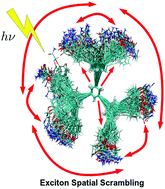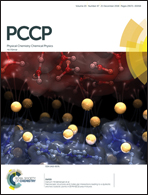Energy transfer and spatial scrambling of an exciton in a conjugated dendrimer
Abstract
Photoexcitation of multichromophoric light harvesting molecules induces a number of intramolecular electronic energy relaxation and redistribution pathways that can ultimately lead to ultrafast exciton self-trapping on a single chromophore unit. We investigate the photoinduced processes that take place on a phenylene-ethynylene dendrimer, consisting of nine equivalent linear chromophore units or branches. meta-Substituted links between branches break the conjugation giving rise to weak couplings between them and to localized excitations. Our nonadiabatic excited-state molecular dynamics simulations reveal that the ultrafast internal conversion process to the lowest excited state is accompanied by an inner → outer inter-branch migration of the exciton due to the entropic bias associated with energetically equivalent conjugated segments. The electronic energy redistribution among chromophore units occurs through several possible pathways in which through-bond transport and through-space exciton hopping mechanisms can be distinguished. Besides, triple bond excitations coincide with the localization of the electronic transition densities, suggesting that the intramolecular energy redistribution is a concerted electronic and vibrational energy transfer process.

- This article is part of the themed collection: 2018 PCCP HOT Articles


 Please wait while we load your content...
Please wait while we load your content...